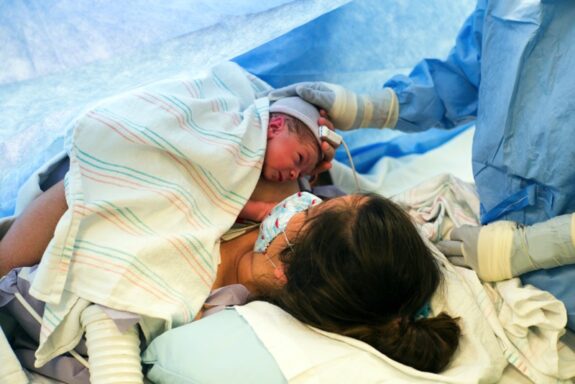For years, experts have been concerned about the rising cesarean rate throughout much of the world. Their concerns center, primarily, around the potential health complications that C-sections pose for both mother and baby – everything from breathing problems to risk of death. One Amish birthing center may hold the secret to reducing those rates, making labor and delivery safer for mothers everywhere.
This potential key was discovered by researchers who examined the birth outcomes of 418 women who had delivered 927 babies at a birthing center in Southern Wisconsin. This facility, set up to give Amish women a safe place to deliver (most Amish deliver at home with only the help of an unlicensed attendant), is staffed by a midwife and family doctor and there isn’t an operating room in which to perform C-sections.
Any women who ended up needing a cesarean were sent to a hospital just 20 minutes away from the clinic to ensure safe delivery. But after examining the data, researchers found that this only occurred in just 4% of the women. This is a stark contrast to the general U.S. population where nearly one-third of all infants are born via cesarean.
There were few complications during birth among the Amish women; the newborn death rate was 5.4 deaths per 1,000 deliveries among the Amish and it is 4.5 deaths per 1,000 deliveries in the general U.S. population. A total of 19 infant deaths occurred at the birthing center, but only one could have been prevented with the help of further medical intervention; no maternal deaths occurred during the course of the study. Women considered at high risk were not included in this particular study and they were referred to a more advanced medical facility.
Study authors say that the biggest reason C-section rates were lower among Amish women was that a higher percentage of women gave vaginal birth after a previous cesarean (VBAC), 95 percent of Amish women compared to just 8 percent in the U.S. population. This portion of the data suggests that previous notions about an increased risk of rupture to the uterus during a VBAC are, for the most part, unsubstantiated; none of the women included in the study experienced this problem, despite the high VBAC percentage rates. The data also coincides with the by the National Institutes of Health’s 2010 recommendation that all women attempt a VBAC before having a subsequent C-section.
Researchers say that another contributing factor was that doctors attempted to turn babies into breech position (feet first) from outside of the womb before suggesting a C-section. According to Fox News, Dr. Lee Dresang, professor at the University of Wisconsin Department of Family Medicine and researcher on the study, says the turning method succeeded most of the time. However, in the general population, 92 percent of breech babies are born via C-section.
Dr. Dresang said that the study findings suggest that following these guidelines could safely reduce cesarean rates among the general population. The benefits would be reaped by mothers and babies, especially where maternal safety is concerned.
According to an analysis conducted by the National Institutes of Health, only 3.8 percent of every 100,000 VBACS resulted in maternal death. In comparison, 13.4 deaths per 100,000 repeat C-sections resulted in maternal deaths. Dr. James Ducey, director of Obstetrics and Maternal Fetal Medicine at Staten Island University Hospital, who was not involved in the study, told Fox News that the findings suggest that birthing centers like this one can deliver babies “almost as safely as people in hospitals do.” He added that the thousands of maternal deaths among the general population may outweigh the benefit of saving that one extra infant life that could have been prevented.
Dr. Dresang says he realizes that it is probably impossible to get the general population C-section rates as low as the Amish clinic’s rates. If, however, the guidelines used at the clinic are followed by mainstream doctors, C-section rates among the general population could be reduced safely and effectively.
Related Articles:
- Progesterone Test Can Help in Diagnosing Ectopic Pregnancies and Miscarriages
- Probiotics may Not Provide Allergy Protection in Children, Study Finds
- Women of Brazil Rediscovering and Fighting for the Benefits of Natural Birth







